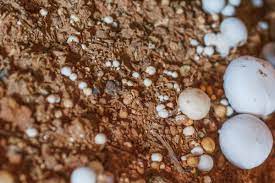Growing plants and gardening can be a very satisfying hobby or an important part of keeping life going through agriculture. However, white fungus in the soil is a problem that both gardeners and farmers have to deal with.
Could it mean bad things for your plants, or is it just a normal, safe part of the soil? In this piece, we will talk about white fungus in soil, its causes, its effects, and whatever is bad for your plants.
This blog will teach you everything you need to know about this interesting part of soil health and plant growth, as well as give you useful tips for keeping your garden or crops healthy.
How to Understand White Fungus

A general term for different kinds of fungus growth that look white or light colored in the soil is “white fungus in the soil.” These fungi come from different species and families, and they can look different, too, like mycelium, which is a network of cells, small structures that look like mushrooms, or even powdery growth on the ground.
Common Causes of White Fungus of Soil
1. Decomposing
White fungus in decomposing soil is often caused by Biological processes that break down organic matter, which is a common reason why white fungus grows in dirt. Fungal matter is very important because it breaks down dead plants into rich compost and releases important nutrients back into the soil.
2. Levels of Moisture
Fungi do best in damp places. Too much water in the soil, whether from too much watering or bad drainage, can help fungi grow, including white fungi.
3. Lack of Aeration
Soil that doesn’t get enough air can also help fungi grow. Some fungi, especially those that do well in low-oxygen settings, can grow well in soil that doesn’t have enough oxygen.
What White Fungus Does to Soil
Most of the time, having white fungus in the dirt is not necessarily bad for your plants. It might be good for you. It is because:
1. Cycling of Nutrients: Many fungi, even white ones, are needed to break down biological matter. They help break down complicated organic materials into simpler forms that plants can use as food.
2. Structure of the Soil: Fungi help improve the soil’s structure. They connect to make a web of mycelium, which holds the earth together and makes it stable.
3. Disease Control: Some fungi, called mycoparasites, can help keep plant diseases at bay by fighting and competing with pathogenic fungi in the soil.
When Should You Worry About the White Fungus?
Most of the time, white fungus in dirt is not a problem. However, there are times when it might be:
1. Plant Health Issues
If the soil has a lot of white fungus and your plants are drooping or showing other strange symptoms, you might want to look into this further. In some cases, some fungal pathogens can hurt the roots of plants or fight with them for food.
2. Overgrowth
Any fungal growth that is too fast, even white fungi, can mean the soil environment is out of balance. It could be because of bad soil management, like using too much organic matter, watering too much, or compacting the soil too much.
Conclusion
Often, seeing white fungus in the dirt shouldn’t be a big deal. It is often an important natural part of the soil environment, helping to move nutrients around, build up the soil, and keep disease at bay. But watching your plants and noticing any signs of illness or stress is very important.
If you suspect white fungi are detrimental to your plants, it might be time to reassess your gardening practices. Learning how to eliminate white fungus on plants involves adjusting your watering habits and ensuring proper soil aeration to create an environment less conducive to fungal growth.
Talking to a gardening expert or the local farm extension office can help you figure out how to keep your soil healthy and deal with any problems that might be caused by white fungus.
Frequently Asked Questions
What Are Some Common Types of White Fungi that Hurt Plants, and How Can I Tell Them Apart?
Powdery mildew, downy mildew, and sclerotinia are some of the white fungi that can hurt plants. Powdery mildew usually shows up on leaves as a white, powdery substance. Downy mildew, on the other hand, usually shows up on the undersides of leaves as fuzzy, white, or brownish spots. On affected plant parts, sclerotinia makes white, cottony mycelium. To identify something, you must look at the specific symptoms and parts of the affected plant.
Are There Any Natural or Organic Ways to Keep Plants from Getting White Fungus?
Yes, you can get rid of white fungus cleanly and organically. Plants can get rid of white fungus with neem oil, baking soda solutions, mill sprays, and solutions made with garlic. Promoting good bugs like ladybugs and ensuring plants are spaced out correctly and clean also helps stop the spread of fungi.
Can the White Fungi that Are on Plants Spread to Other Plants or Crops Nearby in My Garden?
Many pathogens caused by white fungi can spread to other plants. White fungus won’t spread to healthy plants if there is enough space between plants, airflow is good, and affected parts are taken care of at the right time. You can also lower the risk of spreading by checking your yard often and spreading infected plants from healthy ones.


